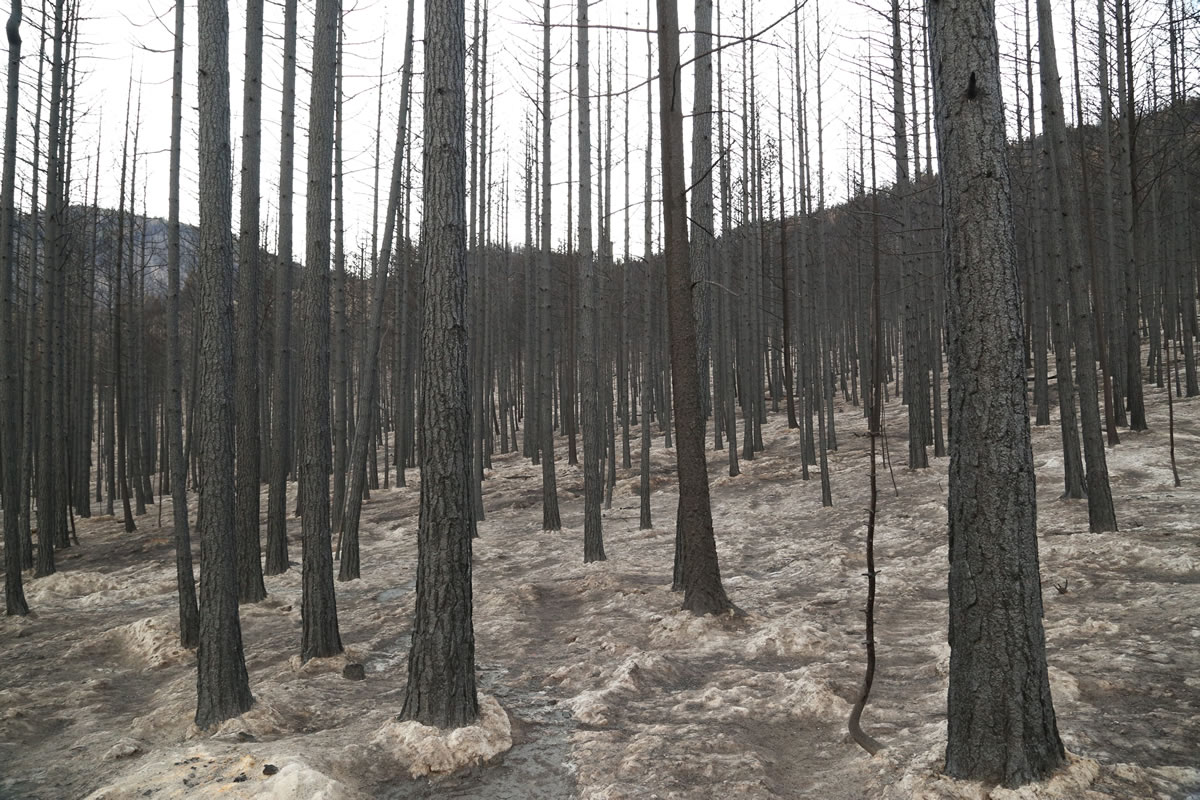WINTHROP — The three crosses are made of tree branches and twine, planted in a charred gully by the side of the road. One is topped by a helmet and a loop of fire hose. A piece of paper is lodged under a rock beside another, though the message is long gone, washed away by rain that came too late.
At this spot, an engine carrying four Forest Service firefighters toppled off the narrow, twisting road as it escaped the “hell storm” of the Twisp River Fire, one of nine wildfires that raced this summer through Okanogan County, on the arid eastern slopes of the North Cascades.
Three men were killed instantly by the smoke and heat: Richard Wheeler, 31, a veteran firefighter who grew up in Michigan; Andrew Zajac, 26, a newlywed from Illinois; and Tom Zbyszewski, the local kid with the goofy grin.
Everyone here knew Zbyszewski. He performed in all the plays at the theater and was a lifeguard at the pool. He delivered the salutatorian address at high school graduation a few years back, calling out each classmate by name. He told them always to remember this valley, their home.
He was 20 years old.
A combustible combination of climate change and bad luck this summer created one of the worst wildfire seasons Okanogan County has seen. All across the West, fires broke records. In Okanogan’s Methow Valley, they broke hearts.
But two months later, faced with huge losses and little sign of letup, residents aren’t fleeing their scorched valley. Instead, they’re digging in, getting ready for when the next fires inevitably come.
The small towns strung along the Methow River are no strangers to wildfires. The golden, shrub-strewn hills and densely forested canyons are fire-prone, even “fire dependent,” as some ecologists put it, and the ranchers, Forest Service employees, off-grid outdoors people and expat Seattleites who live here know to expect smoke in the summer. The bronze firefighter memorial in a local park — positioned where a veterans monument might be in another kind of town — has 17 names on it going back to the 1920s.
But in the past two years, the two largest wildfires in state history have torn through the county. More than 500 homes have been destroyed, roughly two-thirds of them in the Methow area. Towns were evacuated. People went weeks without electricity and running water. And then there were three more names for the memorial — the highest possible price to pay for living in the line of fire.
Wildfires here used to consume maybe a few thousand acres and then burn out, said Susan Prichard, an ecologist for the University of Washington. But climate change and years of misguided forest management that suppressed smaller, healthy fires have “made a less resilient landscape,” she said.
Now, one lightning strike can torch tens of thousands of acres. Even a spark from a worn-out truck wheel can start a blaze. That happened last year, and 10 houses burned before firefighters could control the flames.
“It’s a new normal,” said Prichard, who lives in the valley town of Winthrop. “We’re all grappling with it.”
The new reality is evident everywhere. Carcasses of burnt homes linger among stands of blackened trees. The economy, which used to be sustained by tourism, is now fueled by thousands of firefighters who flock to the Methow each summer — a grim kind of good fortune.
In the poorer southern section of the valley, towns have been all but obliterated, and there’s not nearly enough money to rebuild.
Tom Zbyszewski’s parents live in a single-level house just outside the town of Twisp, 13 miles from the road marked by the three crosses. Jennifer and Richard Zbyszewski are both veteran firefighters and longtime Forest Service employees, and they usually didn’t worry about Tom when he was out on the line. But Jennifer, who still works at the ranger station in Winthrop, felt nervous when she heard over the radio that Tom’s crew was being sent up Twisp River Road to defend some houses in the path of the fire.
When the news came that there had been “entrapments” — the terrifying term for when firefighters are stuck inside a blaze — she called her husband. Hours passed and more phone calls came, each worse than the last. Then the worst one.
Nearly a third of the Methow’s residents — more than 1,500 people — came to the memorial service to remember Andrew, Rick and especially Tom.
No one likes to admit that their home is changing. Over the past two years, fires have burned so fast, hot and violent that even the soil dies, leaving mile after mile of trees as dark and lifeless as telephone poles. The land probably won’t ever recover, said Meg Trebon, an assistant fire management officer for the Forest Service. The idea clearly pains her.
“When a fire happens like this, you see the landscape stripped bare, you see the bones of it,” Trebon said. “It’s like you’re looking at a skeleton.”
Trebon’s job is to develop the forest’s resilience so it burns in a healthier way. That means thinning out excess trees and setting prescribed fires in the spring and fall that burn out the underbrush. Wildfires in treated forests tend to be slower and more manageable, making survival more likely for the trees and the towns around them.
The work is expensive and often unpopular — no one wants to see more smoke. But successive summers of out-of-control fires might be the price of going without.



